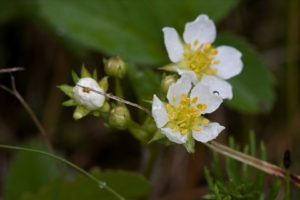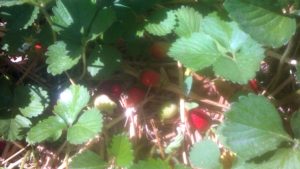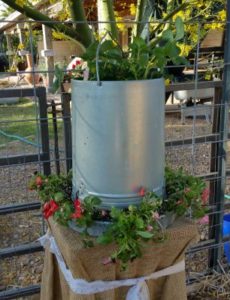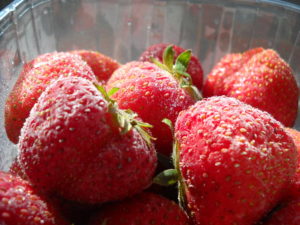Growing strawberries is easy. You can grow strawberries in containers and small gardens to enjoy fresh, naturally grown berries from your own backyard.
Of all crops in the home garden, growing strawberries is one of the easiest and most rewarding. If you have ever had the pleasure of savoring a homegrown strawberry, you know that berries ripened on the vine taste far better than store-bought varieties. For the organic berries and naturally grown berries can be cultivated pesticide free, which is a great advantage since the tender, pitted exterior of a strawberry is difficult to clean and the thin skin absorbs chemicals readily. Additionally, growing strawberries can be much less expensive than it is to purchase them at the market.
Strawberries are a cold-hardy perennial that produce fruits in the spring, with some strawberry varieties producing throughout the summer and into the early fall. This low-growing herbaceous plant produces fruits that are rich in vitamin C, iron and minerals. Surprisingly, the fruit is not a true berry. What we refer to as the berry is actually an enlarged receptacle that houses many achenes, which appear to be ordinary seeds, but in reality are the true fruits of the strawberry plant. The cultivated strawberry plant, Fragaria X ananassa Duch., is a member of the family Rosaceae, subfamily Rosoideae, as are blackberries and raspberries.
This article will explore strawberry varieties and growing strawberries. Planting strawberries, growing them and strawberry harvesting instructions are discussed, as well as storing, freezing and preserving strawberries. Finally, we will conclude with a delicious recipe for Strawberry Mint Jam.
Types of Strawberry Plants
Strawberry varieties fall into one of three main types:
1. June Bearing strawberries produce berries during a 2 – 3 week period in the spring. They are known for their large fruits..They are classified into early, mid-season and late varieties, depending on how early or late in the spring they will begin to produce a harvest. These varieties send out runners that create new strawberry plants.
2. Everbearing strawberries produce berries intermittently during from spring through the fall. They are very good for gardens in which space is limited as they do not send out as many runners as the June bearing varieties, instead spending their energy on producing 2 or 3 harvests each year.The berries tend to be smaller than the June bearing varieties, and after 2-3 years, berry production declines and the plants should be replaced.
3. Day Neutral strawberries are very similar to Everbearing berries, though they will produce fruit continuously throughout the growing season.
Learn more about strawberry varieties here.
Site Preparation and Planting Strawberries
 Site preparation: Choose a site that has not recently had tomatoes, peppers, potatoes or eggplant growing in it to prevent the spread of Verticillium Rot. Plant strawberries in full sun. Provide a light sun protection to the berries if you live in an area with hot summers. Soil should be rich and well-drained. Prepare the soil to a depth of 1 foot, removing any stones or obstacles. Add plenty of compost to the planting bed to keep the soil loose so that roots can grow freely. Strawberries grow best in a soil pH of 5.8 to 6.2.
Site preparation: Choose a site that has not recently had tomatoes, peppers, potatoes or eggplant growing in it to prevent the spread of Verticillium Rot. Plant strawberries in full sun. Provide a light sun protection to the berries if you live in an area with hot summers. Soil should be rich and well-drained. Prepare the soil to a depth of 1 foot, removing any stones or obstacles. Add plenty of compost to the planting bed to keep the soil loose so that roots can grow freely. Strawberries grow best in a soil pH of 5.8 to 6.2.
When to plant: Plant in late fall or early spring.
Planting and spacing: Make a hole in the soil that is large enough to spread the roots. Plant with roots down and the crown up. Backfill the hole with soil, leaving half of the crown exposed.
Space Junebearing crowns 18 inches apart and everbearing/day neutral varieties 12 inches apart. Space rows 4 feet apart.
Container growing: Berries grow very well in containers and hanging baskets. Choose a container that is at least a foot wide and a foot deep and has draining holes in the bottom. Fill the container with a mixture of potting soil and compost. Do not crowd your plants in the pot; space them 12 inches apart.
Strawberry Containers, Crowns and Seeds
The easiest method for growing strawberries is to grow from crowns, often referred to commercially as “bare root strawberries.” You can also grow strawberries from seed. Learn more about starting Strawberries from seed here.
Organic Everbearing Organic Strawberry Bare Root Crowns
Northern Sweet Strawberry Seeds
Cultivation of Strawberry Plants
 Water and feeding: Water on a regular schedule, keeping the soil evenly moist to encourage berry production. Soil should feel as moist as a wrung-out sponge, not waterlogged. Add compost or a low nitrogen fertilizer to the planting bed when June bearing varieties cease bearing for the year. Fertilize between harvests for everbearing/day neutral varieties, but do not fertilize at the end of the season to prevent new growth that may be frost tender.
Water and feeding: Water on a regular schedule, keeping the soil evenly moist to encourage berry production. Soil should feel as moist as a wrung-out sponge, not waterlogged. Add compost or a low nitrogen fertilizer to the planting bed when June bearing varieties cease bearing for the year. Fertilize between harvests for everbearing/day neutral varieties, but do not fertilize at the end of the season to prevent new growth that may be frost tender.
Companion plants: Bush beans and Lupin flowers are excellent plants to grow near strawberries as they fix nitrogen in the soil and attract beneficial insects. Borage and thyme, as well as lettuces, or recommended companion plants, as well. Avoid planting near members of the cabbage family, as the strawberries my impede their growth.
Cultivation: Keep strawberry beds weed free for greatest production. To deter weeds and keep the soil temperature cooler, mulch between plants. Straw is the traditional strawberry mulch, and it helps to keep tender berries off the soil. Do not use black plastic since it can raise soil temperatures, which will inhibit fruit production.When temperatures dip below freezing, mulch over the strawberry plants with straw to prevent frost injury to the crowns.
To encourage the vigor of new plants and greater berry production in the second year, pinch off all flowers and runners until July 1st for ever-bearing and day neutral varieties, allowing fruit to form late in the season.
For June bearing varieties, pinch off all flowers during the entire first year in the garden, allowing runners to grow. As the runners form, train them along the row, spacing them at least 6 inches apart. Without severing the runner from the mother plant, gently press the runner into the soil. Stabilize it in place with a rock or a small amount of soil until roots are formed.
Pests and Diseases: Horseradish has no serious pest or disease problems.
Companion Plants for Strawberries

There are many benefits to growing strawberries in close proximity to other plants. Here are a few useful strawberry companion plants.
Borage: This culinary herb attracts pollinators and predatory insects that prey on strawberry pests. It also has the ability to increase yields, perhaps by adding trace minerals to the soil in which it is planted. And although taste is subjective, it is known to improve the flavor of strawberries near which it is planted.
Bush Beans: Beans attract nitrogen-fixing bacterial that fix nitrogen in the soil, which can improve strawberry growth and yields. They also repel beetles that are pests of strawberries.
Caraway: Caraway attracts parasitic wasps and flies that feed on strawberry pests.
Lupin: Like beans, lupine is a legume that fixes nitrogen in the soil. Its flowers also attract pollinators.
Caution!
Avoid planting strawberries near members of the cabbage family whose growth may be impaired by close proximity with them.. Members of the cabbage family include: broccoli, cauliflower, Brussels sprouts, cabbage, collard greens, kale, kohlrabi, radish and arugula.
Harvesting & Renovation of Strawberries
Harvesting Strawberries: Harvest when berries are fully ripened on the plants. Cut the stem directly above the berry, being careful not to bruise the tender fruit.
Renovation: When growing strawberries, it is important to understand that they do not produce continuously, but tend to go dormant during cold weather. Cultivation strawberries requires plant renovation that will help to keep the crowns vigorous for up to five years. After the final harvest, mow or cut the strawberry plants down to a height of 2-3 inches, being careful not to damage the crowns. Spread a thick layer of compost, or apply a balanced fertilizer according to the package instructions. Lightly till the area between the rows. Remove older plants, and thin younger plants to 6 inches apart.
How to Freeze Strawberries

Growing strawberries may mean that you have too many to eat at once. To freeze whole or halved strawberries, stem, wash and dry them. Lay them in one layer on a cookie sheet or tray lined with wax paper. Place the tray in the freezer. When the berries are frozen, quickly transfer them to a bag and return them to the freezer.
To sugar pack strawberries, follow the instructions above, adding one step: roll the berries in sugar prior to spreading them out on the cookie sheet.
To pack berries in a light sugar syrup, dissolve 1 cup of sugar in 4 cups of lukewarm water. Cool the syrup in the refrigerator. Meanwhile, stem, wash and cut the berries to the desired size. Pack them in a freezer-safe container and pour the syrup over them, just enough to cover the berries. Leave a 1/2 inch to a 1 inch headspace in the top of the container to allow for expansion of the liquid as it freezes.
For more information, The University of Georgia Cooperative Extension Service has published a detailed guide to freezing berries and other fruits:
Preserving Food: Freezing Fruit
Strawberry Jam Recipe

Growing strawberries has an incredible side-benefit: plenty of fresh berries for strawberry jam recipes. One of the best ways to preserve strawberries is to make freezer jam. This recipe requires patience, as the berries need to macerate in the fridge overnight. The waiting will be rewarded with a delightfully sweet jam that bursts with strawberry flavor. A hint of mint rounds out and deepens the flavor, and give the jam a unique flair. Store in the fridge for several weeks, or in the freezer for up to one year.
The recipe calls for raw or pure cane sugar. Resist the urge to substitute beet sugar, which is a cheaper option. If the sugar package does not specify “cane sugar,” the bag probably contains inferior beet sugar, which does not set up as nicely in jam recipes. Use a non-reactive pot, such as ceramic or stainless steel.
I sometimes convert this recipe into strawberry ice cream syrup by using only one packet of pectin and freezing. Yum!
Ingredients
- 5 -6 pints of strawberries (stemmed and washed)
- 1 vanilla bean
- or 1 tsp vanilla extract
- 7 cups raw or pure cane sugar
- 2 lemons
- zested and juiced
- 2 envelopes of liquid pection (they generally come two to a package)
- 4 -6 fresh mint leaves
- 1 tbsp butter
- 10 clean half-pint canning jars or plastic freezer jars and lids
Cook Time
Prep Time: 24 hours
Total Time: 1 day, 30 minutes
Serves: Approximately 10 jars
1. One or two days before you plan to make your jam, roughly chop the berries or whirl them briefly in a food processor. Place them in a non-reactive bowl and cover them with half of the sugar. Slice the vanilla bean lengthwise, and scrape the seeds into the strawberry mixture, or add vanilla extract. Stir, cover the bowl, and place in the fridge to macerate.
2. Put berries, lemon zest and juice, mint leaves and the remainder of the sugar into a large non-reactive pot and bring to a simmer. Cook over medium high heat for about fifteen minutes, until the fruit cooks down and the mixture begins to thicken.
3. Remove the mint leaves. Use an immersion blender or potato masher to crush the berries so that about half of the berries are crushed and half are left intact.
4. Bring the mixture to a boil. Add the butter. When the butter has melted, add in the pectin. If any foam forms on top of the jam, skim it off with a spatula or wooden spoon. Boil the jam rapidly for 10 minutes, being watchful so that it does not boil over.
5. Turn off the heat and lay out your clean jars. Allow the mixture to cool slightly, and then use a wide-mouth funnel or ladle to fill the jars. Immediately, place the lids on them.
6. Allow the jars to cool to room temperature. The jam will last for several weeks in the fridge, or several months in the freezer.
If you prefer to store jam in the pantry, water bath can it (10 minutes for small jars or 15 minutes for pints.)
A wide-mouth canning funnel makes filling glass jars much easier, reducing mess and waste.
The jam recipe calls for a vanilla bean, which are extremely expensive at the local grocery store. A much better value is found here.
Organic or Traditionally Grown Strawberries?
Strawberries are easy to grow using natural methods in the garden, but not everyone is keen on growing strawberries when they are readily available year-round at the supermarket. Grocery stores generally offer both organically and traditionally grown berries. The term “traditionally” should call to mind age-old natural practices, but in modern times “traditionally” refers to practices commonly used during the last hundred years, during which chemical enhancements have become commonplace. Organic practices that are actually centuries old seem new to many gardeners who are used to growing with commercial pesticides, fertilizers and other chemical enhancements.
According to Eating Well magazine, strawberries are one of fourteen foods that are recommended to be purchased or grown organically due to their high pesticide load. But organic produce tends to be more expensive, causing many people to decide to forgo purchasing it. For many , growing strawberries is a better option.
Read more:
A Complete Guide: How to Grow Strawberries and 10 Best Strawberry Recipes by Dianne T. Lampe


